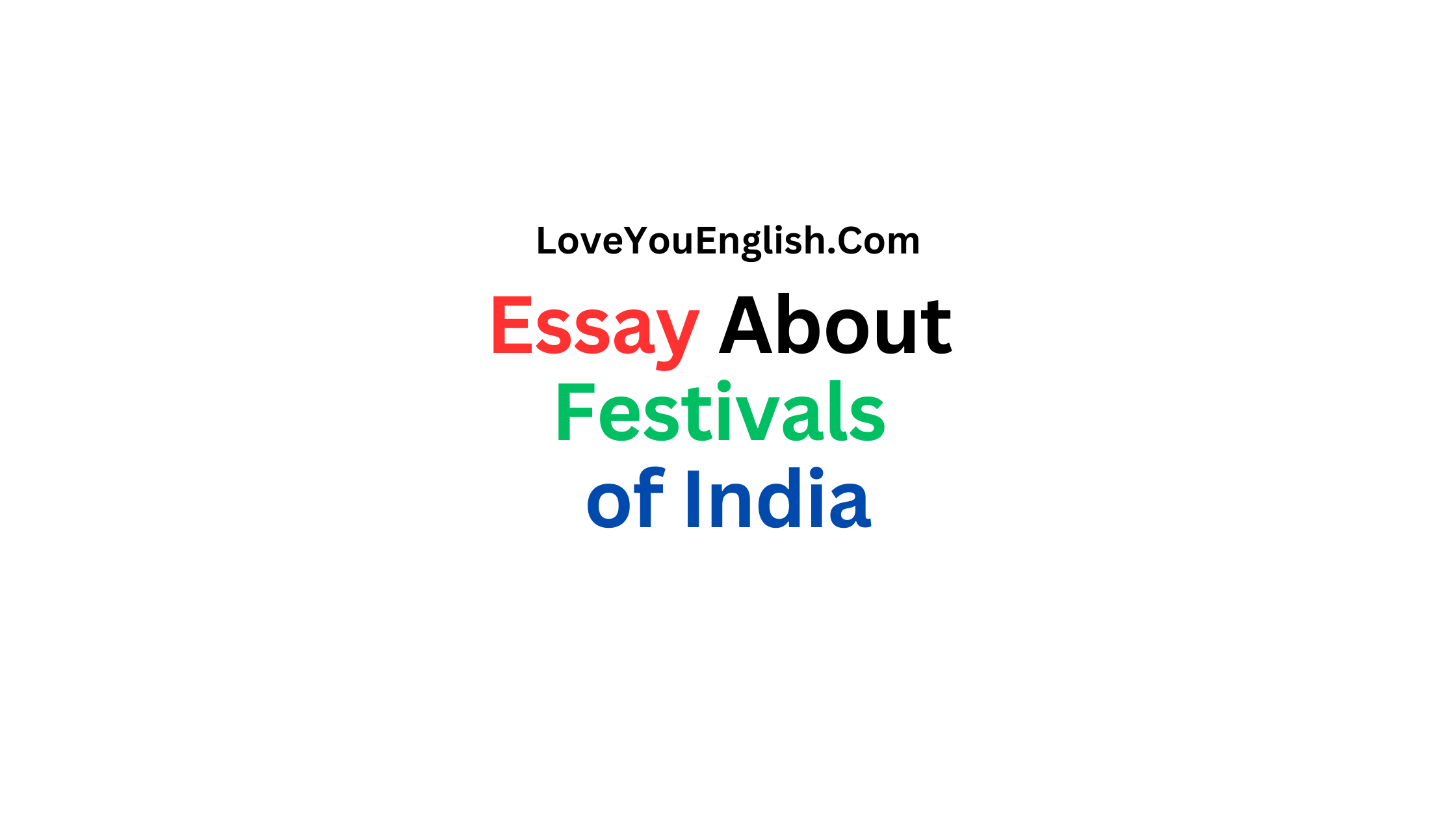Essay About Festivals of India for Students
India is a land of diverse cultures, languages, and traditions, and one of the most colorful aspects of its rich heritage is its festivals.
Festivals in India are celebrated with great enthusiasm, joy, and togetherness.
These festivals bring people from different backgrounds together, encouraging harmony, peace, and love.
The festivals are celebrated with rituals, customs, food, dance, music, and prayers.
In this post, we will explore some of the most popular festivals of India, their significance, and the unique ways they are celebrated.
Table of Contents
Toggle1. Diwali – The Festival of Lights
Diwali, also known as Deepavali, is one of the most important and widely celebrated festivals in India. It is called the Festival of Lights because people decorate their homes with oil lamps or diyas, and burst firecrackers. Diwali marks the victory of light over darkness and good over evil.
Significance:
The festival is associated with Lord Rama’s return to his kingdom after 14 years of exile, during which he fought and defeated the demon king Ravana. People celebrate Diwali to honor Lord Rama, and it also marks the worship of Goddess Lakshmi, the goddess of wealth and prosperity.
How it’s celebrated:
Families clean and decorate their homes with beautiful rangolis (colorful patterns made on the ground) and diyas. People exchange gifts, wear new clothes, and prepare delicious sweets. Diwali is also known for its grand fireworks displays, which light up the night sky.
2. Holi – The Festival of Colors
Holi is one of the most joyful and vibrant festivals in India. It is a celebration of the arrival of spring, the end of winter, and the victory of good over evil.
Significance:
Holi is linked to several myths and stories, but the most popular one is the story of Prahlad, a devotee of Lord Vishnu, who was saved from his evil aunt, Holika, by divine intervention. The festival symbolizes the triumph of good over evil and the joy of life.
How it’s celebrated:
On the eve of Holi, people gather around a bonfire to burn effigies of Holika, symbolizing the destruction of evil. On the day of the festival, people throw colored powders at each other, sing songs, dance, and enjoy sweet treats like gujiya and thandai. It’s a time for forgiveness and renewing relationships.
3. Ganesh Chaturthi – The Festival of Lord Ganesha
Ganesh Chaturthi is a popular festival that honors Lord Ganesha, the elephant-headed god of wisdom, prosperity, and new beginnings.
Significance:
The festival marks the birth of Lord Ganesha, and it is believed that praying to him removes obstacles and brings blessings for success and happiness. It is particularly important in the state of Maharashtra, but it is celebrated all over India.
How it’s celebrated:
People bring home idols of Lord Ganesha, decorate them with flowers and lights, and offer prayers. Large processions are held in some cities, where people carry Ganesha idols to rivers and immerse them in water. The last day of the festival, known as Visarjan, is filled with music, dance, and celebration.
4. Navratri – Nine Nights of Celebration
Navratri is a festival that spans nine nights and is dedicated to Goddess Durga. It is one of the most significant Hindu festivals and is celebrated with a lot of devotion and excitement.
Significance:
Navratri celebrates the victory of Goddess Durga over the buffalo demon Mahishasura. The nine nights symbolize the different forms of Goddess Durga, who is worshipped for her power and strength.
How it’s celebrated:
Navratri is celebrated with fasting, prayer, and dance. In some parts of India, people perform garba and dandiya dances, especially in Gujarat. On the tenth day, known as Dussehra, people celebrate the defeat of the demon king Ravana by Lord Rama, and the victory of good over evil.
5. Eid – The Festival of Breaking the Fast
Eid is an important festival for Muslims in India and around the world. It marks the end of Ramadan, the holy month of fasting. The festival is celebrated with prayers, feasts, and acts of charity.
Significance:
Eid celebrates the end of Ramadan, during which Muslims fast from dawn to dusk. It is a time of gratitude to Allah (God) for the strength to complete the fast, and to seek blessings for peace and prosperity.
How it’s celebrated:
On Eid, Muslims gather for special prayers at mosques, followed by feasts with family and friends. Traditional dishes like biryani, sewaiyaan (sweet vermicelli), and sheer khurma (a sweet milk-based dessert) are enjoyed. People also give zakat (charity) to help those in need.
6. Christmas – The Birth of Jesus Christ
Christmas is celebrated by Christians in India and around the world to mark the birth of Jesus Christ. It is a time for family gatherings, feasts, and giving.
Significance:
Christmas celebrates the birth of Jesus Christ, who is believed to be the Son of God. Christians believe that Jesus brought peace, love, and salvation to the world, and his birth is a time for reflection and gratitude.
How it’s celebrated:
People decorate Christmas trees with lights and ornaments. In many homes, a special meal is prepared, and families come together to celebrate. Churches hold midnight Mass services, and people exchange gifts and greetings. Christmas cakes, cookies, and sweets are prepared and shared with neighbors and friends.
7. Raksha Bandhan – The Bond of Protection
Raksha Bandhan is a special festival that celebrates the bond between brothers and sisters. The festival is centered around the tying of a rakhi, a sacred thread, by sisters on the wrist of their brothers.
Significance:
Raksha Bandhan celebrates the love and protection between siblings. Sisters tie a rakhi on their brothers’ wrists, and in return, brothers promise to protect and care for their sisters.
How it’s celebrated:
On Raksha Bandhan, sisters prepare a puja (prayer) thali, which includes a rakhi, sweets, and other offerings. The sister ties the rakhi on her brother’s wrist, applies a tilak (a red mark) on his forehead, and prays for his well-being. The brother then gives a gift or money to his sister as a token of love.
8. Onam – The Harvest Festival of Kerala
Onam is the most important festival in Kerala, celebrated by Malayalees across the world. It marks the homecoming of King Mahabali, a legendary ruler, and is a celebration of the harvest season.
Significance:
Onam celebrates the golden rule of King Mahabali, who is believed to visit his people during this festival. It is a time to celebrate nature’s abundance, family, and community.
How it’s celebrated:
Onam is marked by elaborate feasts, known as Onam Sadhya, which include a variety of vegetarian dishes served on a banana leaf. Traditional dances like thiruvathira and pulikali (tiger dance) are performed. People also create beautiful flower carpets, called pookalam, in front of their homes.
9. Makar Sankranti – The Harvest Festival
Makar Sankranti is a harvest festival that is celebrated in different parts of India, but it is particularly important in the states of Gujarat, Maharashtra, and Punjab.
Significance:
Makar Sankranti marks the transition of the sun into the zodiac sign of Capricorn (Makar). It is a festival that celebrates the harvest and the arrival of longer days.
How it’s celebrated:
People fly kites, enjoy sweets made from sesame seeds and jaggery, and take holy dips in rivers. In Punjab, it is celebrated with the festival of Lohri, which involves bonfires and traditional dances like bhangra and gidda.
10. Janmashtami – The Birth of Lord Krishna
Janmashtami is a celebration of the birth of Lord Krishna, the eighth incarnation of Lord Vishnu. Krishna is beloved for his teachings, miracles, and playful nature.
Significance:
Janmashtami marks the birth of Lord Krishna, who is believed to have come to Earth to rid it of evil and guide humanity toward righteousness.
How it’s celebrated:
On Janmashtami, devotees fast, sing devotional songs, and offer prayers to Lord Krishna. In many places, people reenact the life of Krishna through dramatic performances known as Rasa Lila. Some regions, especially in Uttar Pradesh and Gujarat, celebrate the Dahi Handi tradition, where groups of young men form human pyramids to break a pot of yogurt suspended high above.
Conclusion
India’s festivals are more than just celebrations; they are a reflection of the country’s diverse culture, rich history, and spiritual traditions.
Whether it’s the lights of Diwali, the colors of Holi, or the prayers of Eid, each festival has its own unique charm and brings people together.
These festivals are an essential part of Indian life, reinforcing bonds of family, community, and faith.
Festivals in India are a time of joy, togetherness, and love, and they provide an opportunity to experience the beauty of India’s heritage and traditions.
No matter which festival it is, the essence remains the same: to spread happiness, share blessings, and celebrate life.







